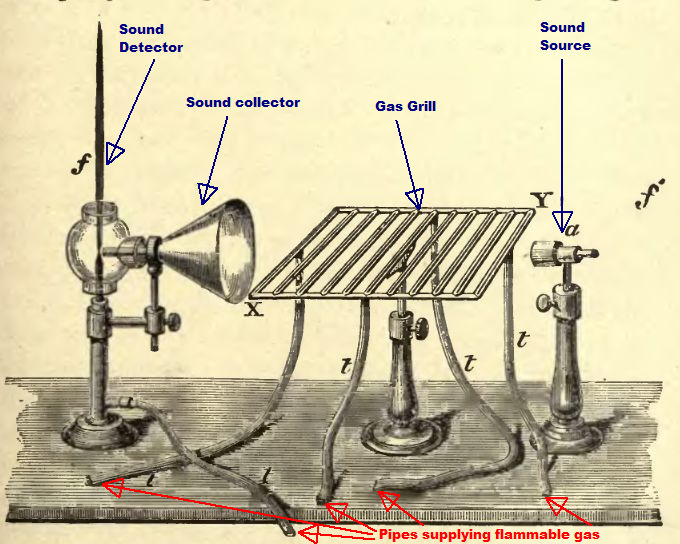Image: Tyndalls setup for demonstrating reflection of sound in air
Description: One of John Tyndall's setups for demonstrating reflection of sound in air. The tall black object on the left labeled f in the illustration is a flame from flammable gas, which is coming out of a small nozzle under high pressure. The sound-collecting cone directs the sound to the base of this tall flame, just above the nozzle. At the tall flame's base, tiny compressions and decompressions to the air from sound waves cause tiny changes in the flow of the gas, which cause non-tiny, visible wobbles and flutters higher up the flame column. When there is no sound, the tall flame is perfectly erect and tranquil. This is Tyndall's sound detector (largely developed by himself, after he got the original basic idea from John Le Conte). The sound generator emits a high pitch, and it's emitted in a directed way via a small cone. In the center of the illustration is a set of ordinary or low-pressure gas burners. When some of these burners are lit, the volume of sound that reaches the sound detector is reduced; and when all of them are lit, no sound at all reaches the detector. (A large set of weak burners is more effective at blocking the sound than a smaller set of stronger burners). Now, Tyndall relocated the sound collecting & detecting unit to the place marked f' on the righthand side of the illustration, behind the sound emitter. When the grill is off the detector doesn't detect the sound at this new location. But when the grill is on, the sound is detected there. Thus, the lit grill has reflected the sound (bounced it like an echo). The direction the sound is reflected to can be shaped by shaping the array of gas burners. The difference between the lit and unlit grill is essentially heat and the low-density air associated with heat. Although the air density disparities are very high in this experiment, the experiment is taken to demonstrate that sound is reflected at the interfaces between air masses of different densities, more generally.
Title: Tyndalls setup for demonstrating reflection of sound in air
Credit: Illustration appears in John Tyndall's book "Fragment of Science, Volume One". It has been taken from an electronic copy of the book at Archive.Org (1896 edition of the book) and subsequently annotated in colored typeface.
Author: John Tyndall
Usage Terms: Public domain
License: Public domain
Attribution Required?: No
Image usage
There are no pages that link to this image.


